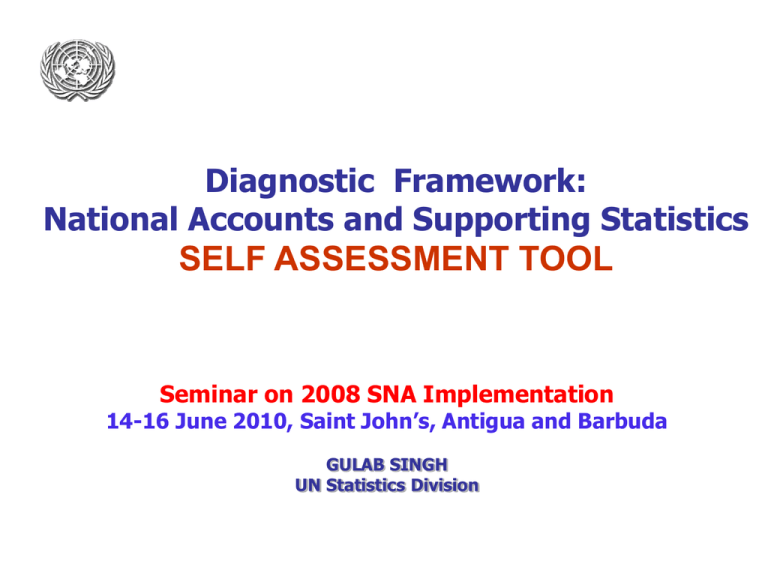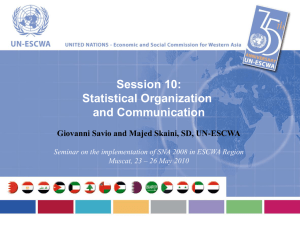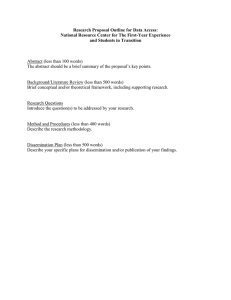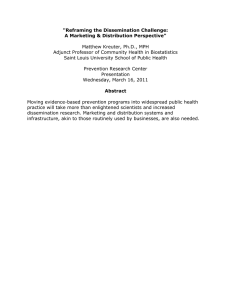SELF ASSESSMENT TOOL Diagnostic Framework: National Accounts and Supporting Statistics
advertisement

Diagnostic Framework: National Accounts and Supporting Statistics SELF ASSESSMENT TOOL Seminar on 2008 SNA Implementation 14-16 June 2010, Saint John’s, Antigua and Barbuda GULAB SINGH UN Statistics Division 1 Outline of presentation Elements of DF tool (for this session) • Communication and dissemination • Organisation and management of statistical organization Self Assessment Diagnostic Tool Communication • Website • Electronic format • Paper copies Dissemination • Accessibility • Serviceability Self Assessment Diagnostic Tool Organisation and management of Statistical organization • • • • Legal environment National Statistical Council Consultations with users Human resource management ▫ ▫ ▫ ▫ Training and capacity building programmes National training institutes Career planning Management training • ICT management ▫ Modernization of ICT environment Data Dissemination Accessibility: Data and metadata are easily available and assistance to users is adequate. Data accessibility- Statistics are presented in a clear and understandable manner, forms of dissemination are adequate, and statistics are made available on an impartial basis. Metadata accessibility- Up-to-date and pertinent metadata are made available. Assistance to users- Prompt and knowledgeable support service is available. Data Dissemination - Indicators Accessibility of data: Statistics are presented in a way that facilitates proper interpretation and meaningful comparisons (layout and clarity of text, tables, and charts). Dissemination media and format are adequate. Statistics are released on a preannounced schedule. Statistics are made available to all users at the same time. Statistics not routinely disseminated are made available upon request. Data Dissemination - Indicators Accessibility of metadata: Documentation on concepts, scope, classifications, basis of recording, data sources, and statistical techniques is available, and differences from internationally accepted standards, guidelines, or good practices are annotated. Levels of detail are adapted to the needs of the intended audience. Assistance to users: Contact points for each subject field are publicized. Catalogs of publications, documents, and other services, including information on any changes, are widely available. Management of Statistical Organization Legal and institutional environment- The environment is supportive of statistics. Indicators: The responsibility for collecting, processing, and disseminating the statistics is clearly specified. Data sharing and coordination among data-producing agencies are adequate. Individual reporters’ data are to be kept confidential and used for statistical purposes only. Statistical reporting is ensured through legal mandate and/or measures to encourage response Management of Statistical Organization National Statistical Council An apex national body for statistical matters Advisory Committees • Expert Groups Consultations with users Users are consulted in deciding the statistical agenda User producer conference User satisfaction suryes Human Resources Management Human Resources - are commensurate with needs of statistical programs in both qualitative and quantitative terms. Indicators: Staff, facilities, and financing are commensurate with statistical programs. Measures to ensure efficient use of resources are implemented. Training and investment on human capital is provided. Human Resources Management Training and capacity building programmes The supply of professionals with the skills required in a statistical agency is as a rule scarce. Introductory cycle: • Designed for newly recruited staff, • purpose is to ensure their speedy integration into the organization, which implies • both becoming familiar with the traditions of the statistical agency and being able to make a contribution in any of the domains or functions within its scope. Training and capacity building Intermediate cycle: Designed primarily for those who have worked in a statistical agency for a period of five to ten years and who have not had an opportunity to refresh their skills; The administrative cycle: Those who have the potential to fill policymaking positions within their respective agencies should be trained in the subjects that will demand their energies once they reach management levels National training institute Training of statistical personnel at all levels Collaboration with academic institutions Human Resources Management Career Planning Staff retention - major challenges for every office, whether large or small, well or poorly endowed Job satisfaction Comparable remuneration ICT Management The effective management of IT in a statistical office is a careful balance of management discipline coupled with the innovative application of new and progressive technologies. Indicators: • Attention from top-level management in ensuring that computing resources are commensurate with statistical programs; • Effective risk analysis in guiding direction; • Avoidance of untried leading-edge technologies; • End-user involvement in project formulation and management. • A deliberate organizational strategy and management model for managing in-house versus outsourced technical skills. ICT Management An ICT policy exists for the organization Software used for compiling and analyzing data are effectively and periodically updated Visits to website are monitored Thank you


